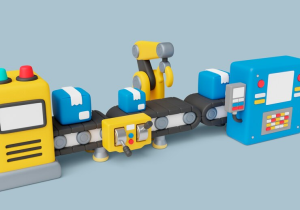From Cost Savings to Advanced Features: The Best IT Solutions for Manufacturing
7 min read
The manufacturing industry has undergone a profound transformation over the past few decades, driven largely by advances in technology. The integration of IT solutions into manufacturing processes has not only streamlined operations but also enhanced efficiency, reduced costs, and opened new avenues for innovation. In this article, we will explore the best manufacturing IT solutions that range from cost-saving measures to advanced features that revolutionize production lines.
The Evolution of IT in Manufacturing
IT solutions in manufacturing have evolved from simple automation tools to sophisticated systems that integrate every aspect of the production process. Early adoption focused on basic automation to reduce human error and increase production speed. Today, manufacturing IT solutions encompass a wide array of technologies including the Internet of Things (IoT), artificial intelligence (AI), machine learning (ML), big data analytics, and cloud computing.
Cost Savings Through IT Solutions
1. Enterprise Resource Planning (ERP) Systems
ERP systems are a cornerstone of manufacturing IT solutions. They integrate various business processes such as inventory management, procurement, accounting, human resources, and production planning into a single unified system. This integration reduces redundancy, enhances data accuracy, and enables better decision-making.
Benefits of ERP in Manufacturing:
- Improved Efficiency: Automates routine tasks and streamlines workflows.
- Cost Reduction: Minimizes inventory holding costs through better inventory management.
- Enhanced Productivity: Provides real-time data to manage resources more effectively.
2. Lean Manufacturing and Just-In-Time (JIT) Production
Lean manufacturing and JIT production are methodologies supported by IT solutions to minimize waste and optimize production schedules. IT systems enable precise tracking of materials and components, ensuring that they arrive exactly when needed, thus reducing storage costs and improving cash flow.
Key IT Tools:
- Inventory Management Software: Tracks inventory levels in real-time.
- Supply Chain Management Systems: Coordinates with suppliers to synchronize delivery schedules.
- Production Scheduling Software: Plans production runs based on real-time demand.
3. Predictive Maintenance
Predictive maintenance uses IoT sensors and data analytics to predict when equipment is likely to fail, allowing maintenance to be performed just in time to prevent unplanned downtime. This approach reduces maintenance costs and extends the lifespan of equipment.
Key Technologies:
- IoT Sensors: Monitor equipment conditions such as temperature, vibration, and pressure.
- Big Data Analytics: Analyzes sensor data to predict failures.
- Machine Learning: Improves predictive algorithms over time with more data.
Advanced Features of Modern Manufacturing IT Solutions
1. Internet of Things (IoT)
The IoT connects machines, devices, and systems in a manufacturing environment, enabling them to communicate and share data. This connectivity enhances monitoring, control, and automation of manufacturing processes.
Applications of IoT in Manufacturing:
- Smart Factories: Real-time monitoring and control of production lines.
- Asset Tracking: Real-time tracking of materials and finished goods.
- Energy Management: Monitoring and optimizing energy usage to reduce costs.
2. Artificial Intelligence and Machine Learning
AI and ML are revolutionizing manufacturing by enabling systems to learn from data and make intelligent decisions. These technologies are used in quality control, process optimization, and predictive analytics.
Applications of AI and ML:
- Quality Control: Automated inspection systems that use computer vision to detect defects.
- Process Optimization: Analyzing production data to optimize workflows and reduce bottlenecks.
- Demand Forecasting: Predicting future demand to adjust production schedules accordingly.
3. Digital Twins
A digital twin is a virtual replica of a physical object or system. In manufacturing, digital twins are used to simulate and analyze production processes, helping to identify inefficiencies and test changes before implementing them in the real world.
Benefits of Digital Twins:
- Improved Design: Simulate new designs to optimize performance.
- Operational Efficiency: Monitor and optimize production processes in real-time.
- Predictive Maintenance: Simulate equipment performance to predict failures.
4. Additive Manufacturing (3D Printing)
Additive manufacturing, commonly known as 3D printing, is transforming production by enabling the creation of complex parts with fewer materials and less waste. It is particularly useful for prototyping and small batch production.
Advantages of Additive Manufacturing:
- Flexibility: Rapid prototyping and production of customized parts.
- Material Efficiency: Reduces waste compared to traditional manufacturing.
- Cost-Effective: Lower production costs for small batches and complex designs.
5. Cloud Computing
Cloud computing provides scalable, on-demand computing resources that enable manufacturers to handle large amounts of data without investing in expensive infrastructure. It supports various applications such as ERP, CRM, and big data analytics.
Key Benefits:
- Scalability: Easily scale computing resources up or down based on needs.
- Cost Savings: Reduces the need for significant upfront capital investment in IT infrastructure.
- Accessibility: Access data and applications from anywhere, enabling remote work and collaboration.
Integrating IT Solutions in Manufacturing
The integration of IT solutions in manufacturing requires a strategic approach to ensure that the technologies align with business goals and processes. Here are some steps to consider when implementing manufacturing IT solutions:
1. Assess Current Capabilities
Before adopting new technologies, it is essential to assess the current capabilities and identify areas that need improvement. This assessment involves evaluating existing systems, processes, and workforce skills.
2. Define Objectives
Clearly define the objectives you aim to achieve with the new IT solutions. These objectives could include reducing costs, increasing production efficiency, improving product quality, or enhancing customer satisfaction.
3. Develop a Roadmap
Develop a roadmap that outlines the steps needed to implement the IT solutions. This roadmap should include timelines, resource allocation, and key milestones. It should also consider potential risks and how to mitigate them.
4. Choose the Right Technologies
Select the technologies that best meet your objectives and are compatible with your existing systems. Consider factors such as scalability, ease of integration, and support from the technology provider.
5. Train the Workforce
Ensure that your workforce is adequately trained to use the new technologies. Training programs should be tailored to different roles within the organization and focus on both technical skills and change management.
6. Monitor and Evaluate
After implementation, continuously monitor the performance of the IT solutions and evaluate their impact on your operations. Use key performance indicators (KPIs) to measure success and identify areas for further improvement.
Case Studies: Successful Implementation of IT Solutions in Manufacturing
Case Study 1: Siemens’ Smart Factory
Siemens, a global leader in manufacturing, has successfully implemented a smart factory in Amberg, Germany. The factory uses IoT, AI, and robotics to achieve highly automated and flexible production. Real-time data from IoT sensors and machines is used to monitor production processes, predict maintenance needs, and optimize workflows. As a result, the factory has achieved a significant increase in productivity and a reduction in defect rates.
Case Study 2: General Electric’s (GE) Predix Platform
General Electric (GE) has developed the Predix platform, an industrial IoT platform that enables manufacturers to connect machines, collect data, and analyze it for insights. GE uses Predix in its own manufacturing facilities to optimize operations and improve product quality. For example, in GE’s aviation division, the platform is used to monitor the health of jet engines in real-time, predicting maintenance needs and reducing downtime.
Case Study 3: BMW’s Use of Additive Manufacturing
BMW has integrated additive manufacturing into its production processes to produce complex parts and prototypes quickly and cost-effectively. The company uses 3D printing to produce customized parts for its luxury vehicles, reducing the time and cost associated with traditional manufacturing methods. This approach has enabled BMW to bring new designs to market faster and more efficiently.
The Future of Manufacturing IT Solutions
The future of manufacturing IT solutions looks promising, with emerging technologies set to further revolutionize the industry. Here are some trends to watch:
1. Advanced Robotics and Automation
Robotics and automation will continue to advance, with more sophisticated robots capable of performing complex tasks alongside human workers. Collaborative robots (cobots) are already being used in many manufacturing environments to enhance productivity and safety.
2. Augmented Reality (AR) and Virtual Reality (VR)
AR and VR technologies are being used for training, maintenance, and design in manufacturing. For example, AR can provide workers with real-time information and guidance as they perform tasks, while VR can simulate production environments for training purposes.
3. Blockchain Technology
Blockchain technology has the potential to enhance transparency and traceability in supply chains. By providing a secure and immutable record of transactions, blockchain can help manufacturers ensure the authenticity and quality of their products.
4. Edge Computing
Edge computing involves processing data closer to the source of data generation rather than in a centralized data center. This approach can reduce latency and improve the performance of IoT applications in manufacturing, enabling real-time decision-making.
5. Sustainable Manufacturing
Sustainability is becoming a critical focus for manufacturers. IT solutions that support energy management, waste reduction, and resource optimization will play a crucial role in helping manufacturers meet their sustainability goals.
Conclusion
The integration of IT solutions in manufacturing is no longer a luxury but a necessity. From cost savings to advanced features, these technologies are transforming the industry by enhancing efficiency, reducing costs, and enabling innovation. As manufacturers continue to embrace digital transformation, the future holds exciting possibilities for even greater advancements and improvements in manufacturing processes.
By leveraging the right manufacturing IT solutions, companies can stay competitive, meet customer demands, and achieve their business objectives. The key to success lies in a strategic approach to implementation, continuous monitoring and evaluation, and a commitment to training and development of the workforce. With these elements in place, manufacturers can fully realize the benefits of IT solutions and drive their operations to new heights.




